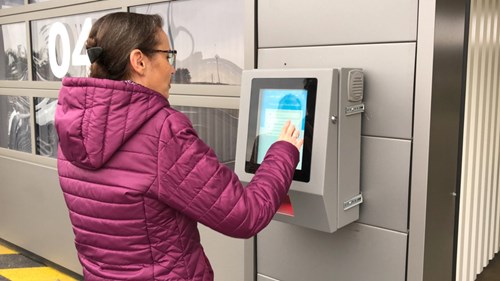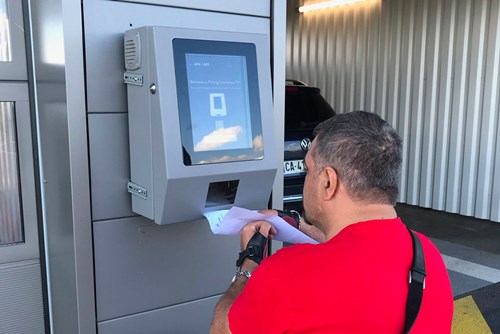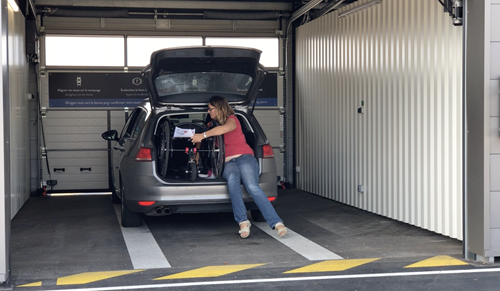
Last year, we launched our first testing on an outdoor robot parking at Lyon Saint-Exupéry Airport. But more than convenient and secure parking, the robot-based parking is also inclusive toward mobility impairments. In order to design our outdoor robot parking effectively, we needed to question our assumptions and think empathically.
The Full Picture
When speaking of disabilities, we might think first of motor or visual disabilities. Truth is that a lot more is taken into account when designing for mobility. In the case of our Robotic Parking, we wanted all of our users who are able to travel alone to be able to use our service without external help. To this our research focused solely on disability defined as difficulties in functioning in any of the following domains: seeing, mobility and dexterity, remembering and concentrating. In order to do so, we observed people in context and then conducted user interviews to gain a comprehensive, empathic understanding of their needs.
Somehow, Standards Are Not Enough
Regarding travel preparation, once persons with impaired mobility are looking for a parking spot on the internet they first search for texts and generic pictograms to identify which solution will fit their needs. Most of the time, the problem is that many websites lack accessibility symbols, even when standards exist and can reduce doubts.
"Often it is not easy to find accessibility information on websites. When you want to book a hotel with a reduced mobility room for example, even in those who specify that they have one, there is no symbol so you have to call. It always ends with the phone." — Eric
Therefore most parking websites could indicate more contextual information like a dedicated path or a parking spot by showing a map, including photos and videos of their facilities, and add accessibility clues when touchpoints are designed to be accessible. Doing so could not only reduce doubts but also increase parking bookings, which are privileged by car park operators to better manage their flows.

Disabilities Are Not All The Same
Speaking of cognitive disorders, people affected by dyspraxia struggle most in visual-spatial memory. For them, reading texts and maps or following a direction is generally a difficult task. Small texts, small letter, and line spacing result in poorer reading time and comprehension. To help them use the service it is important to reduce cognitive loads — such as visuals with lots of content, or hard-to-read texts and graphics—, hence allow them to identify important elements more easily. Another thing we noted with dyspraxia is that in the context of parking, noise pollution impacts their focus capacity greatly, making the parking experience before a long trip even more stressful.
"In general, I try to see if there is a site that indicates things, but more generally I come with someone. For example, if I have a video that explains how it works, I'll see that there's nothing complicated." — Christine

Sebastien, one of our research participant is quadriplegic, meaning he cannot walk or use his fingers to hold or pinch an object. To compensate for his disability, he uses non-slip gloves that allow him to hold or hang on to surfaces. This kind of disability does not concern all people with reduced mobility, yet are not necessarily solved by the design of accessible parking. In order to confirm the deposit of their car, users have to scan their booking on a kiosk after parking. Our kiosks, for example, were a little bit too high for wheelchair users, so setting them on a lower height improved their experience. To this day the current kiosk design could certainly be improved further for the next versions, like allowing them to have a support point making it easier to scan their booking.

Rain (as well as snow) is also a major inconvenience for people using wheelchairs. This is due to the time required to switch from the vehicle to the wheelchair, as well as the accumulation of rainwater in the seat, which is very difficult to dry out and can cause physical harm. Thanks to our cabins, all users can peacefully unload their car and confirm deposit without having to worry about being wet.
"It takes time to get in the chair, the cabin keeps the chair dry as long as possible."— Sebastien

Our participants also mentioned that many issues they encounter are caused by behaviors of non-disabled people. Think of street furniture on pedestrian paths (dustbins, streetlights, bollards etc.) or sometimes cars carelessly parked near/on an accessible spot.
"When you do something, you try to get as much information as possible to know what you are going to be confronted with. The goal is to know if we will be able to move alone or find someone in his entourage who is available to accompany us." — Bernard
Where Technology Meets Universality
When we did our first workshops with Lyon’s airport to define what would the user journey looks like, we focused on our users which did not include those with disabilities. That was a major mistake. Since the user journey was defined and most contact points were designed way before on-site installation, the later accessibility research has shown some flows, which caused resources to be wasted fixing them. Sure you can resolve friction points afterward, however, things get harder when you are working on ongoing project development.
We learned the hard way that when speaking of inclusivity, you have to aim for it since day one. It is also important to stress that the creation of a fully accessible parking system benefits not only for persons with reduced mobility but also for all users.
As designers and researchers we are responsible for accessibility within the product strategy, but more empirically the company’s values. Our study participants allowed us to enhance what people can achieve, anticipate what they need, reduce bias and increase opportunities. Thanks to them, Stanley Robotics is able to offer an inclusive, and more accessible outdoor robot parking. We also hope our parking will help disabled people to feel less discriminated and travel more.
About Stanley Robotics
Stanley Robotics is a venture-backed company that was created in January 2015, and is  headquartered in Paris, France. It is developing an automated valet parking service with robots that can move any vehicle and increase capacity in existing car parks by up to 50%, while revolutionizing the user experience.
headquartered in Paris, France. It is developing an automated valet parking service with robots that can move any vehicle and increase capacity in existing car parks by up to 50%, while revolutionizing the user experience.
The three founders, Clément Boussard (CEO), Aurélien Cord (CTO) and Stéphane Evanno (COO), all have previous experience in driverless technology (at top research institutes and with a world-class industrial corporation).

